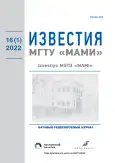Development of a dynamic model of a front loader for the analysis of operational properties and determination of loads acting on its elements
- Authors: Chichekin I.V.1, Nyrkov F.A.1, Grigoruev V.S.2
-
Affiliations:
- Bauman Moscow State Technical University
- Chuvash State University
- Issue: Vol 16, No 1 (2022)
- Pages: 71-80
- Section: Transport and transport-technological facilities
- URL: https://journals.rcsi.science/2074-0530/article/view/108869
- DOI: https://doi.org/10.17816/2074-0530-108869
- ID: 108869
Cite item
Full Text
Abstract
BACKGROUND: For front-end loaders, it is important to minimize energy consumption when performing loading and unloading operations. To ensure competitive properties at a given time of folding links, lifting and with sufficient power of the steering and boom and bucket control drives. This requirement significantly affects the autonomy, versatility and, ultimately, the economic efficiency of loading and unloading operations.
AIMS: Development of a dynamic model of a front loader to determine various operational properties and loads in the joints when working in specified load conditions.
METHODS: A dynamic model has been developed and its operation has been simulated in a system for calculating the dynamics of coupled bodies. The mathematical model includes all the main elements of a front loader – drive axles, internal combustion engine, generator, steering hydraulic cylinders, cargo, bucket, rear axle, cab, wheels, bucket lifting and tipping mechanism, load-bearing system, support surface, TED drive of the driving wheels. The elements are modeled using graphical primitives, hinges and power ones from the standard library of the application for calculating the dynamics of connected bodies.
RESULTS: The article presents a description of a mathematical model of a front loader made in the application for the calculation of connected bodies. A typical list of load modes is presented and examples and simulation results are shown. Possible areas of use of the described mathematical model are shown.
CONCLUSIONS: The developed dynamic model of the front loader makes it possible to analyze various design solutions at the early stages of design, such as the model and number of electric motors, kinematics of the bucket lifting and tilting mechanism, steering kinematics, etc. for energy costs during typical operations. In addition, the developed dynamic model allows you to determine the loads in the hinges and power connections, which can be used when performing strength calculations or when selecting loader components.
Full Text
##article.viewOnOriginalSite##About the authors
Ilya V. Chichekin
Bauman Moscow State Technical University
Email: hiv2@mail.ru
ORCID iD: 0000-0001-7632-7657
SPIN-code: 4060-0720
Cand. Sci. (Engin.), Associate Professor of the Department of Wheeled Vehicles
Russian Federation, 5, 2-ya Baumanskaya av., Moscow, 105005Filipp A. Nyrkov
Bauman Moscow State Technical University
Email: nfa18m127@student.bmstu.ru
ORCID iD: 0000-0003-3431-8116
SPIN-code: 8208-7643
student of the Department of Wheeled Vehicles
Russian Federation, 5, 2-ya Baumanskaya av., Moscow, 105005Vladimir S. Grigoruev
Chuvash State University
Author for correspondence.
Email: wsgrig@chuvsu.ru
ORCID iD: 0000-0003-3437-9541
SPIN-code: 4989-7923
Senior Lecturer of the Department of Mechanical Engineering Technology
Russian Federation, CheboksaryReferences
- GOST 31555-2012. Building front-end single-bucket loaders. Specifications. Available from: https://docs.cntd.ru/document/1200102390. Accessed: Jun 13, 2022. (In Russ).
- Smirnov AN, Avramenko PV. Rekomendatsii po povysheniyu energoeffektivnosti odnokovshovykh frontal’nykh pogruzchikov pri ekspluatatsii. Minsk: BGATU; 2020. (In Russ).
- Bazanov AF, Zabegalov GV. Samokhodnye pogruzchiki. 2nd ed. Moscow: Mashinostroenie, 1979. (In Russ).
- Borovkov YA, Drobadenko VP, Rebrikov DN. Osnovy gornogo dela: uchebnik dlya stud. uchrezhde-nii sred. prof. obrazovaniya. Moscow: Izdatel’skii tsentr «Akademiya»; 2012. (In Russ).
- Kolga AD, Gavrishev SE. Increase in efficiency and widening the field of use of automobile transport in pits. Dobycha, obrabotka i primenenie prirodnogo kamnya. Sbornik nauchnykh trudov. Tom 3. 2003:179−191. (In Russ).
- Grant M. Hydraulic Excavators vs Wheel loaders [Internet]. Quarry Academy. 2016. Available at: https://www.911metallurgist.com/blog/wp-content/uploads/2016/01/Hydraulic-Shovel-vs-Wheel-Loader.pdf. Accessed: Jun 13, 2022.
- Berry T. The first Articulated Wheel Loader [Internet]. Jan.25th, 2013. Available at: https://www.constructionequipment.com/first-articulated-wheel-loader. Accessed: Jun 13, 2022.
- Metin Özdoğan, Hakkı Özdoğan. Wheel Loader Buckets & Digging Forces [Internet]. Sep 2019. Available from: https://www.researchgate.net/publication/335618855. Accessed: Jun 13, 2022.
- Vdovin D, Chichekin I, Ryakhovsky O. Quad bike frame dynamic load evaluation using full vehicle simulation model. IOP Conference Series: Materials Science and Engineering. 2019;589(1). doi: 10.1088/1757-899x/589/1/012025
- Gorelov VA, Komissarov AI. Mathematical Model of the Straight-line Rolling Tire – Rigid Terrain Irregularities Interaction. Procedia Engineering. 2016;150:1322-1328. doi: 10.1016/j.proeng.2016.07.309
- Vdovin D, Chichekin I. Loads and Stress Analysis Cycle Automation in the Automotive Suspension Development Process. Procedia Engineering. 2016;150:1276–1279. doi: 10.1016/j.proeng.2016.07.285
- Vdovin DS, Chichekin IV, Levenkov YY. Predicting the fatigue life of a semi-trailer suspension elements at the early stages of design. Trudy NAMI. 2019;(2):14-23. (In Russ).
- Pacejka HB. Tyre and Vehicle Dynamics. Oxford: Butterworth Heinemann; 2006.
- Pacejka HB, Besselink IJM. Magic Formula Tyre Model with Transient Properties. Vehicle System Dynamics. 1997; 27 sup001:234–249. doi: 10.1080/00423119708969658
- TNO Automotive: MF-Tool 6.1 User Manual. Netherlands, 2008.
- GOST ISO 5010:2011 Earth-moving machinery. Steering requirements for rubber-tyred machines. Available from: https://docs.cntd.ru/document/1200096396. Accessed: Jun 13, 2022. (In Russ).
Supplementary files

















